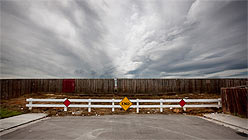Mike Tyson once said “Everybody’s got plans…until they get hit.” And while some might not think of Tyson as a particularly prophetic individual, I’d challenge them to find a more fitting way to describe Kirk Crippens’s photographs of Stockton, California, which has been called the epicenter of the housing crisis.
Stockton is a nice town (twice awarded the All-America City Award by the National Civic League). Being relatively inexpensive and within commuting distance to Sacramento and San Francisco made it prime real estate for speculators cashing in on the housing boom, and swathes of planned communities sprung up around the city. Two years ago, the same qualities left Stockton vulnerable; when the housing bubble popped, 1 in 27 Stockton homes ended up in foreclosure.
Kirk Crippens’s photographs chronicle the economic crisis at the most personal level, as it reverberates through the daily lives of Californians. The photographs in Foreclosure, USA, taken during 2008 and 2009, feature the dissolution of planned communities: sidewalks abruptly dead-ending into dirt; the detritus left behind by squatters in foreclosed houses; swimming pools, empty except for a puddle of yellow scum and rings of dirt.

Photo: Kirk Crippens
Gallery info states Crippens was inspired by the famous documentary photographs of the dustbowl, but to me, the analogy doesn’t exactly work: when I think of most famous dustbowl photographs by artists like Dorthea Lange and Walker Evans, I think of the faces of migrant workers and sharecroppers. Crippens’s photographs are different: they are gorgeous images that manage to capture the affective landscape of human emotion in upheaval, without ever including a single person on film. He does this by shooting emptied homes: abandoned by owners, repossessed by banks, and gutted by looters. The object is the same though: the Farm Security Administration hired photographers to show the human side of the dustbowl to people who weren’t directly experiencing it; Crippens’s project, funded in part by grants from SFMOMA, the Sierra Club, and the Museum of African Diaspora, functions similarly.




